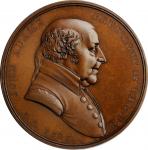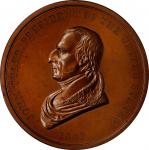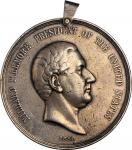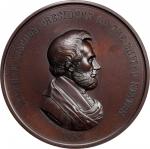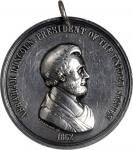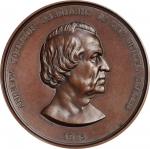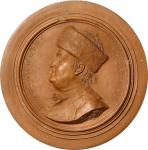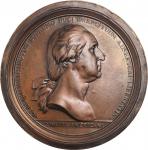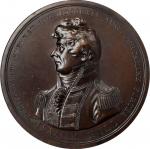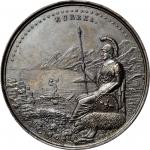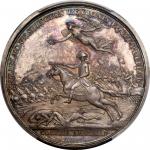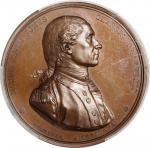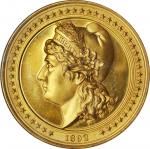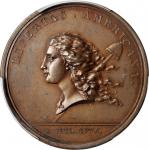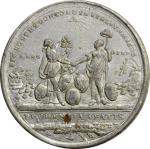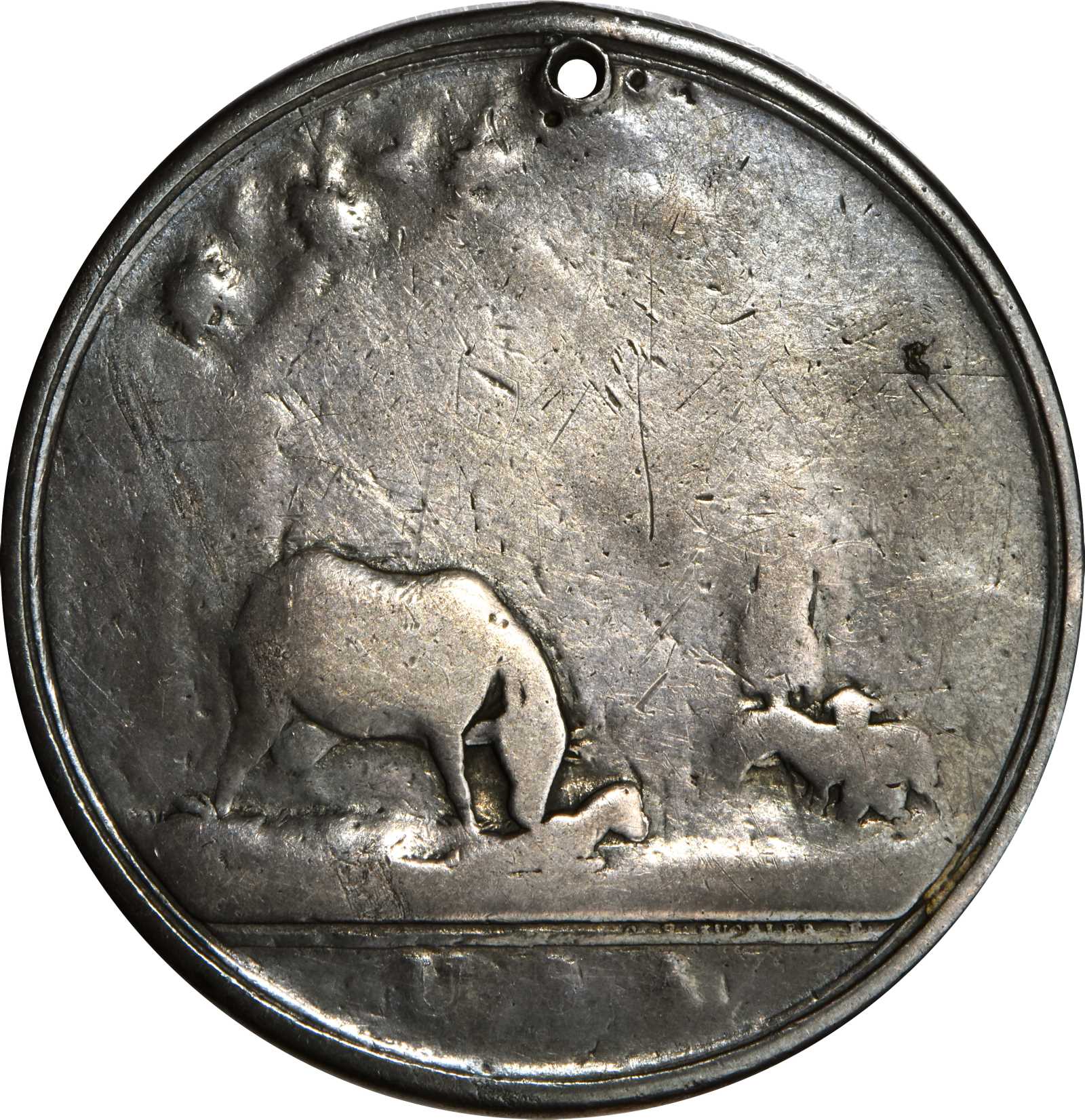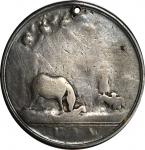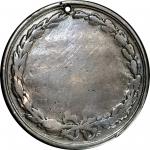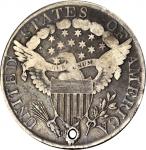Pair of Field Worn Indian Peace Medals as Distributed by Lewis and Clark, ca. 1804.These two Indian Peace Medals are invaluable historic artifacts of virtually equal significance. The lifecycle of one is somewhat conventional and as intended, while the other was employed in a fashion that its creators would never have envisioned. Individually they are significant, but as a pair they testify to the narrative of our earliest efforts in diplomacy with the Native American tribes of the Pacific Northwest. "1796" (1798) Washington Seasons Medal. The Shepherd. Silver. 47.7 mm. 672.2 grains. Clarks 4th Size. Musante GW-67, Baker-170, Julian IP-51. Fair-2, holed.
Holed for suspension at 12 oclock, with two small dimples near the hole on the obverse and another along rim on the reverse. A well-worn nub remains along the edge at 12 oclock where the original hanger once was before breaking away. The obverse patina is rich silver-gray at the centers and transforms to gunmetal blue towards the peripheries, while the reverse alternates between gunmetal blue and silver-gray shades. The surfaces are generally worn smooth and glossy from very advanced circulation wear, with the reverse legends worn away essentially completely. Just light undulations remain where the lettering used to be, and the wreath is intact if well worn. The obverse is similarly well worn, but faint hints of the letters U.S.A. are visible below the exergual line. The high relief cow, calf, lambs, and shepherd are at least partially visible, and outlines of the tree and house are visible at left and upper left periphery. A thin band of granularity at the left obverse is similar to a rubber band stain but is undoubtedly where a leather cord lay across the medal at some point when it was stored away. Likely the most field worn survivor of a Seasons Medal in existence!
The Seasons medals, as they have come to be known, exist at an intersection of the medallic Washington and Indian Peace Medal series, much like the famous Oval Indian Peace Medals produced from 1789 through 1795. The Seasons medals comprise three distinct issues known individually as The Shepherd, The Farmer, and The Home, with each one depicting a specific scene of domestic life. Together, they were intended to demonstrate the aspirational lifestyle of a civilized society.
The series was conceived by George Washington himself and was explained in a speech to the Cherokee Nation that took place in Philadelphia on August 29, 1796. He suggests that he will soon "leave the great town and retire to [his] farm" where he will "attend to the means of increasing my cattle, sheep…to the growing of corn, wheat and other grain, and to the employing of women in spinning and weaving: all which I have recommended to you." Washington closes by saying that he will speak to "the Secretary of War, to get prepared some medals, to be given to such Cherokees as by following my advice, shall best deserve them."
We see that Washington is true to his word, as the medals were authorized soon after by Secretary of War James McHenry on October 10, 1796. The designs were conceived by famous American artist John Trumbull, and the medals were struck by the firm Boulton and Watt in Birmingham, England from dies engraved by Conrad Kuchler. It would take nearly two years before the first batch of medals was ready for delivery, and the first shipment in July 1798 included 326 examples in silver and an unknown number in bronze. By then, Washington had retired to Mt. Vernon in March of 1797 and the task of distributing the medals was left to the John Adams administration. It appears that a substantial quantity remained in the War Department as of 1803, which is when we see 55 examples taken to explore the Pacific Northwest by Lewis and Clark. Specialist Francis P. Prucha suggests that all of these were silver and that all three issues, including The Shepherd, The Farmer, and The Home, were represented.
Described as the "4th size" medal in the journals of Lewis and Clark, they served as valuable tools of diplomacy throughout their journey. This is demonstrated by a journal entry from August 17, 1805, which describes the distribution of gifts that day. Clark writes that Cameahwait, the brother of Sacagawea, received a small size Jefferson Indian Peace medal, along with a coat, shirt, scarlet leggings, tobacco, "and some small articles." In addition, "Each of the other chiefs received a small medal struck during the presidency of General Washington, a shirt, handkerchief, leggings, a knife and some tobacco. Medals of the same sort were also presented to the young warriors who, though not chiefs, were promising youths, and very much respected in the tribe."<p>Though each of the three types had mintages in silver of about 150 pieces with mounts and 17 without mounts, along with fewer in copper, principally copper examples have survived. Any Seasons medal in silver is a significant rarity, and field worn examples are even more elusive. The Ford Collection, far and away the single largest grouping of Indian Peace medals ever assembled, included four silver Seasons medals. Ford II (2004) included a well worn, once-mounted, Farmer (also known as The Sower), while Ford XVI (2006) included a mounted Shepherd (undergraded as Choice Very Fine), a mounted Farmer (graded Very Fine), and a never-mounted Home. The Shepherd earned the highest priced of them all, selling for $57,500. Most recently, we offered an example of The Shepherd graded SP-58 (PCGS) in our August 2018 ANA Auction. It had never been mounted or worn, but brought a strong price of $33,600.
The Seasons medals many not be as famous as the presidential portrait Indian Peace Medals that commenced with the Jefferson administration. However, their official distribution was nonetheless an important part of the earliest efforts at establishing diplomacy between Native Americans and the juvenile United States. The present example is surely one of the most desirable survivors of this issue, having clearly been put to good use. <p><strong>1799 Draped Bust Silver Dollar. Clarks 5th Size. BB-161, B-11. Rarity-3. Fine-12, holed. </strong><p>406.7 grains. Toned in deep golden gray patina with lighter silver shades at the high points of the devices and legends. Some brighter friction is noted from poor storage at Miss Libertys hair and upper face, as well as across the upper parts of eagle and wings. It has been neatly holed at 12 oclock between E and R of LIBERTY, somewhat far from the rim. The edge lettering remains intact, and the surfaces display the wear, rim and edge marks associated with wear in the field. This piece is likely unique among Indian Peace Medals, as it is the only silver dollar of the United States with ties to our early efforts of diplomacy throughout the Pacific Northwest.
Though less famous than their medallic brethren, United States silver dollars, presumably of the present Draped Bust type, played an important role in the journey of Lewis and Clarke. They were used most often in trade alongside other trinkets such as watches, textiles, beads and jewelry. However, we see at least one instance of a silver dollar serving explicitly as an Indian Peace Medal in place of the more formal medals distributed. In the entry for October 29th, 1804 in William Clarks journal, he writes that they "Collected the Chiefs and Commenced a Council" in order to deliver a speech to several different tribes. At the end of this speech, they called on the Chief of the Arikara tribe, Arketarnarshar, to help them make peace with the others through a communal smoking session.
Arketarnarshar had been selected as a guide and interpreter by Lewis and Clark, as he was supposedly fluent in eleven languages in addition to the sign language that served as a universal means of communication among the tribes. For his services, Clark remarks that he "gave this Cheaf a Dollar of the American Coin as a Meadel with which he was much pleased." Identifying this piece as a "Meadel" implies that it was holed, or otherwise mounted for suspension, and intended to be worn as the more conventional medals were. <p>
Indian Peace Medal scholar Francis Prucha suggests that silver dollars may have even been officially recognized for their role as diplomacy medals. William Clark mentions five distinct sizes of medals on the inventory created at the start of their journey, but he fails to specify the details for each size. The first four sizes have been confidently correlated with a specific medal type, though the nature of the fifth size is never clarified. Writing in his 1971 reference, Prucha suggests that "it is possible that the [fifth size]... refers to an American silver dollar, pierced for suspension as a medal" as is presently offered. He also notes a journal entry on January 10, 1806 that refers to a "medal of the Smallest Size," which might be another mention of the silver dollar as a medal. However, researcher Gary Moulton suggests that this is probably a reference to the smallest size Jefferson medal available, the 55 mm format referred to as the "3rd Size" elsewhere. Even so, it is clear that silver dollars like this specimen were awarded in an official capacity at least once, and were used to barter more informally many times. They are important piece in the puzzle of our early diplomacy and deserve just as much recognition as their more conventional Indian Peace Medal peers.
It is very likely that these two Indian Peace medals have been together since the 1804 expedition of Lewis and Clark, over 200 years ago. For the most recent century, they have been treasured in the collection of a single family, having been passed down through the generations before being consigned to this sale. The earliest ancestor in this chain of custody did not know exactly what he had but was still able to recognize these items as significant. He was a collector of Native American artifacts relating to the Columbia River Basin and formed a vast collection that was eventually gifted to the Smithsonian. These two medals were the only items kept by the collector. He acquired them together in the early 20th century but had not been able to properly identify them. In December 1914 he wrote to the Smithsonian Institution in Washington, DC, offering photographs of his "Indian specimens" for study, likely referring to the present items. A couple years later on July 12, 1916 he supplied a tracing, presumably of the Washington Seasons medal, to the Department of the Interiors Office of Indian Affairs in search of more information. The Chief Clerk C. F. Hauke wrote back just a few days later that "This office is unable to identify the one of which you make a tracing. However, there are publications relating to medals [which]…may be the means of placing you on the track of the exact information you desire."
Answers would not be found until 55 years later when researcher Emory Strong published an article in the May 1971 issue of <em>Northwest Magazine</em> asking for submissions of tokens and medals relating to the Lewis and Clark expedition. The collector had since passed and the medals were now in the care of his son, who saw the article and reach out to Emory for more information. Emory, along with his wife and fellow researcher Ruth, were able to authenticate these pieces and shed some light on their relation to the Lewis and Clark expedition. <p>The medals have since passed down through several more generations but their significance has not been forgotten. It was expressed by the family decades ago that these pieces should remain together as they always have been, and we are delighted to be offering them as a pair to the next generation of collectors. They represent an irresistible opportunity for advanced specialists of Indian Peace Medals or Native American artifacts, though collectors of Washington medals and early dollars will also be drawn in by the incredible historic significance.Acquired in the early 19th century by a collector of Native American artifacts in the Pacific Northwest and passed down in the same family since.

